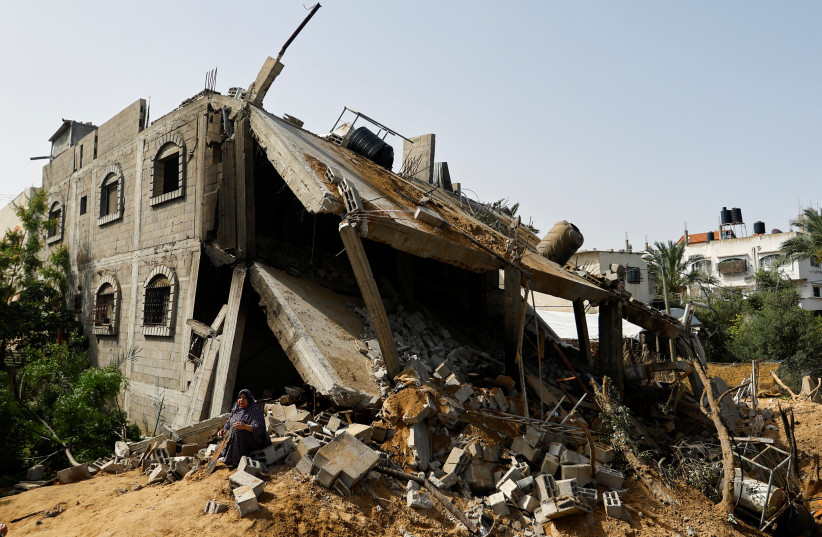On Saturday night, the fighting in Gaza – referred to in Israel as Operation Shield and Arrow – came to an end. It was the latest round of five days of fighting and in the defense establishment, there is little doubt that the next round is just a matter of time. Islamic Jihad still has rockets, it still has a desire to kill Israelis and Iran is still there, pulling the strings from behind the scenes.
From a military perspective, the IDF can be satisfied with its performance during this latest clash. The opening blow – that took out three top Islamic Jihad operatives in a surgical multi-target operation – showed how Military Intelligence, the Shin Bet (Israel Security Agency) and the Air Force have upgraded their ability to carry out surgical targeted killings. It is one thing to know the building terrorists are in; it is another to pinpoint the apartment and the room in which they are sleeping.
This was evident from the images of the different targeted strikes. One building showed a blown-out apartment on the ground floor; another on the top floor on just one corner. In one case, a team of IDF engineers carefully studied the inside walls of an apartment to assess exactly how the rubble will fall when a missile flies through the house. Their assessment was that children sleeping in a nearby room would be okay. They were.
Others, tragically, were not. While Israel makes an effort not seen in other military forces to avoid civilian casualties, this is warfare and there are, sadly, going to be casualties. And while the world tends to look at the conflict from the perspective just of numbers – 33 killed in Gaza and two in Israel – let’s remember that while Iron Dome had a 95% success rate, when it fails, that costs lives.
Inga Avramyan, 80, was killed in Rehovot after an apparent malfunction of the Iron Dome. Over 1,100 rockets that were fired crossed into Israel. While most of the rockets projected to strike civilian centers were intercepted, imagine what would have happened had there not been Iron Dome or if it had malfunctioned more than just a few times. The number of casualties on the Israeli side would have been exponentially higher. So, because they are intercepted, Israel should not be able to defend itself? That is ludicrous.
AND HERE are the numbers: the IDF bombed over 700 targets in Gaza, many of them homes, buildings and Islamic Jihad rocket positions. The number of dead according to Gaza health officials – which sadly included civilians – was 33.
The IDF says that at least half of those killed were terrorists, and they have most of the names to prove it. Some of the civilians were killed by Islamic Jihad’s own rockets, out of which 291 misfired and landed in Gaza.
According to information released by the IDF, for example, one misfired rocket killed Rami Shadi Hamdan, 16, and Ahmed Muhammad a-Shabaki, 51, in the Gaza town of Beit Hanoun and, in another incident, a failed launch killed Layan Bilal Mohammad Abdullah Mdoukh, a 10-year-old girl, and Yazan Jawdat Fathi Elayyan, 16, in Gaza City.
Every life lost is a tragedy. But think about this: over 700 Israeli strikes and 12-14 civilians were maybe killed by Israel. When looking at the way wars are fought today, this is a ratio that is simply not seen – except in Israel.
Israel has done and will continue to do all it can to prevent civilian casualties. Sometimes it will not be possible and sometimes there will be mistakes. Overall, when looking at the planning and execution, the IDF again showed a new level of precision on the modern battlefield. For that, it deserves some credit.
New government decisions shelling out funds to coalition partners
Where credit is missing, though, is when it comes to Israeli economic policy and this was a week of economic news. First was the local councils’ decision to strike against the Treasury’s proposed Arnona Fund, which, in a nutshell, takes the earnings of wealthier local authorities from city taxes and redistributes them to weaker ones.
Then there was the vote in the Finance Committee about the private funds that are distributed to members of the coalition to buy their support. The current coalition – as expected – is breaking all previous records, allocating over NIS 13 billion for various projects.
The mere fact that such a budgetary system exists is ridiculous. The allocation of funds to private MKs so they can fund organizations and projects that are dear to their hearts, is simply wrong at its core. You have a project? Put it through the organized system overseen by ministries. Not this way.
There is money that is going, for example, to promote the legacy of certain rabbis or former controversial politicians. Some MKs asked for money to promote “family purity” in Jewish families or to build a visitor’s center in Hebron.
THE MOST prominent amount – nearly NIS 3.9b. – is earmarked for yeshivot that do not include secular studies or professional training, and for haredi private and semi-private schools that do not have Education Ministry oversight and are – as a result – not required to teach English and math.
This marks a 29% increase in funding for institutions that do not contribute to haredi men joining the Israeli workforce, versus just a 1% increase in funds earmarked for programs to integrate haredim into the workforce and into society.
And after all that, it was no surprise when on Tuesday, Shira Greenberg, the Finance Ministry’s chief economist, issued a report downgrading Israel’s projected economic growth for 2023 from 3% to 2.7% percent.
While these three developments might not seem connected, they are. The idea of creating a greater balance between wealthy and poor local councils, on the surface, makes sense. Taking the money, though, from the property taxes of Tel Avivians to fund social services in Ofakim though does not make sense, especially at a time when the country clearly has billions of shekels to allocate for coalition funds.
But when the government does not do that, and instead pours money into programs and institutions that do the complete opposite of creating economic growth, it is no surprise that Greenberg modified the projected growth for the coming year.
The people these funds are mostly going to hurt are the ones who the money is supposedly going to – the haredim. While the ultra-Orthodox politicians look at the narrow gain that they received in more money for kolels and yeshivas, in the longer term, this money will actually turn into a curse.
So much money allocated for a purpose that does not create economic growth but rather stagnation is the kind of spending that forces an increase in interest rates, which then leads to an increase in the price of goods, mortgages and cost of living.
In other words, while it might seem like yeshiva students are getting a bump up in their monthly stipend today, down the road it will make life unsustainable, first and foremost for the haredi community and eventually for almost all Israelis.
Prime Minister Benjamin Netanyahu knows this and was the person – who as finance minister in 2003 – cut child allowances, which he wrote in his recent autobiography, “threatened to eventually collapse Israel’s economy.”
As he wrote in his book, the reform he implemented promoted economic growth and helped grow workforce participation from 54% in 2003 to 64% by 2018. “After trailing the OECD average for years in job participation rate, Israel was rapidly catching up with the rest of the developed world,” he wrote.
The decisions this week are the exact opposite of “catching up” with the developed world and can be better described as “falling behind.” As written in this column in the past, the greatest challenge Israel faces in the years to come is not from Iran, Hezbollah or Hamas but rather the possibility that Israel’s economy will become unsustainable if more ultra-Orthodox men do not start working.
Instead of spending money on yeshiva and kolel stipends, the Knesset should be allocating funds to programs that encourage haredi integration into the workforce and help them get an education and high-level skills so they can then find a high-earning job.
The future of Israel depends on this.
The writer is immediate past editor-in-chief of The Jerusalem Post.

